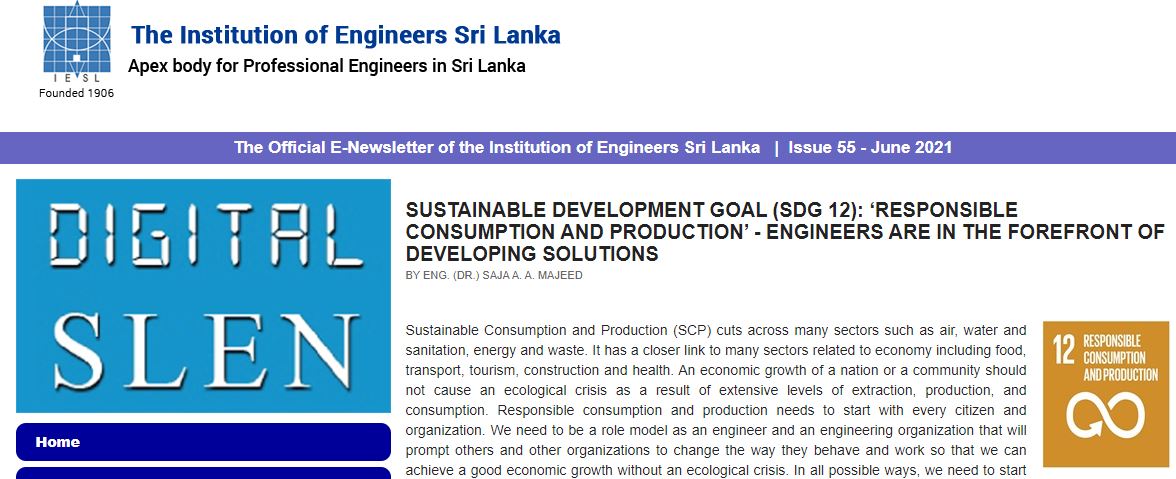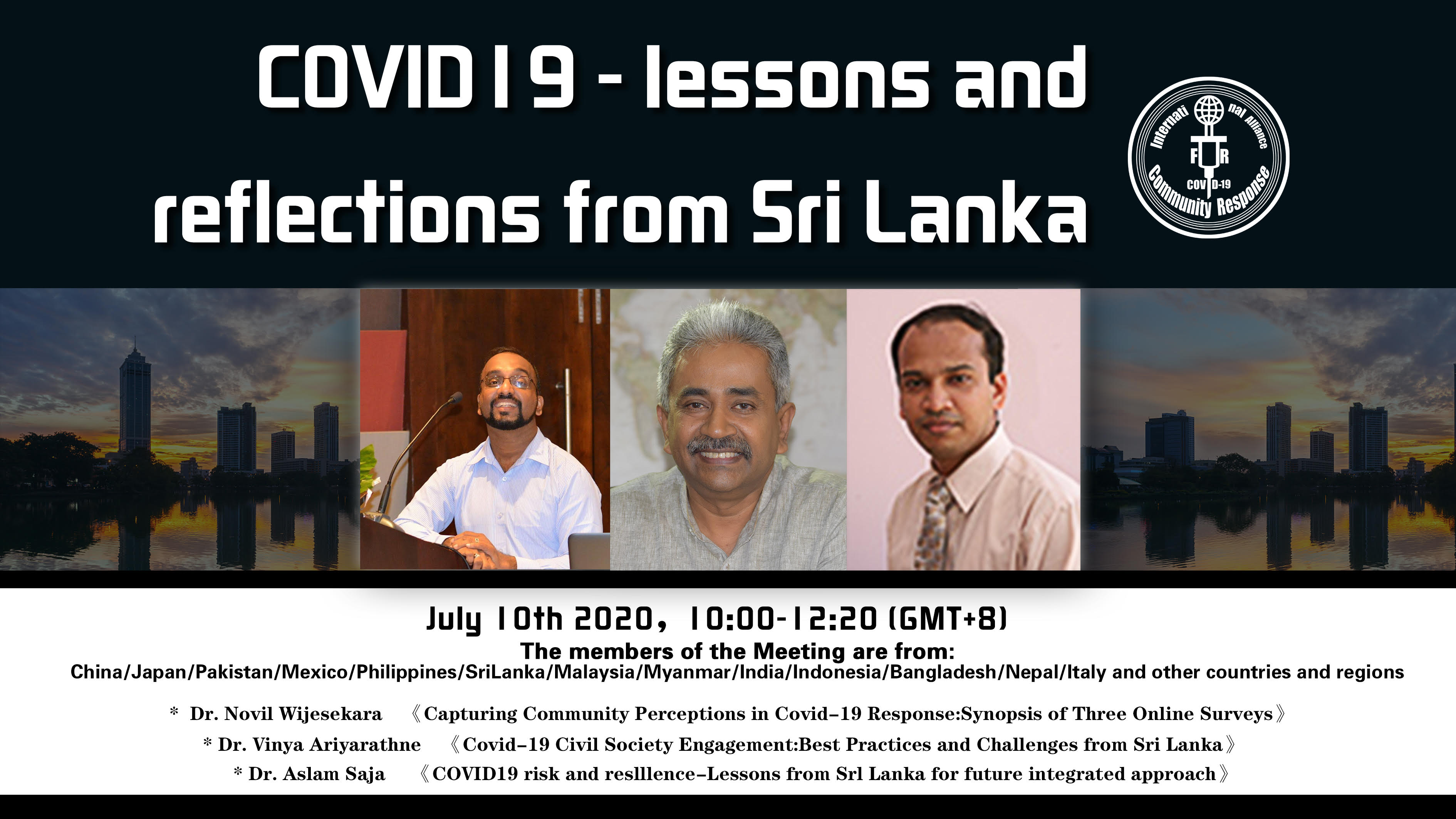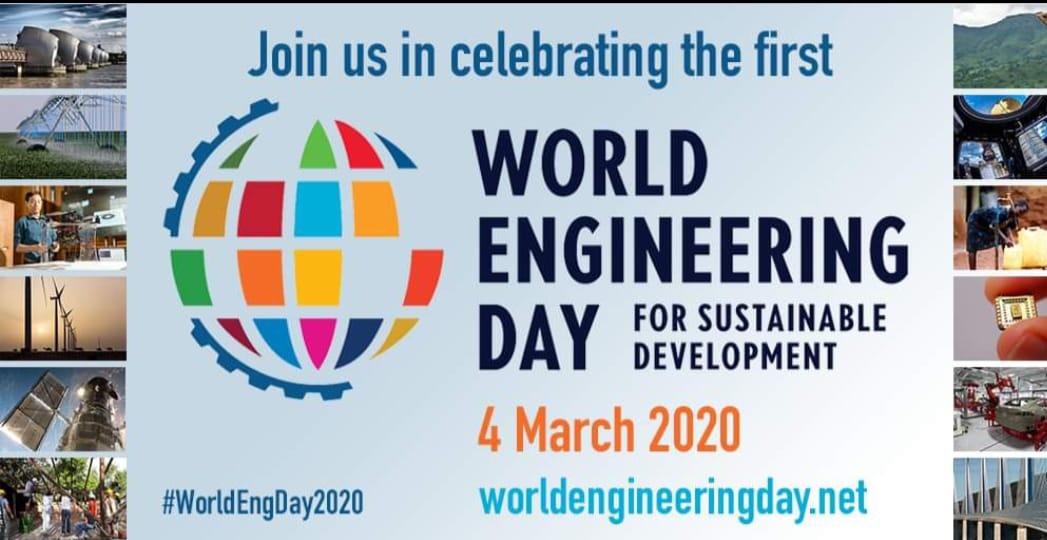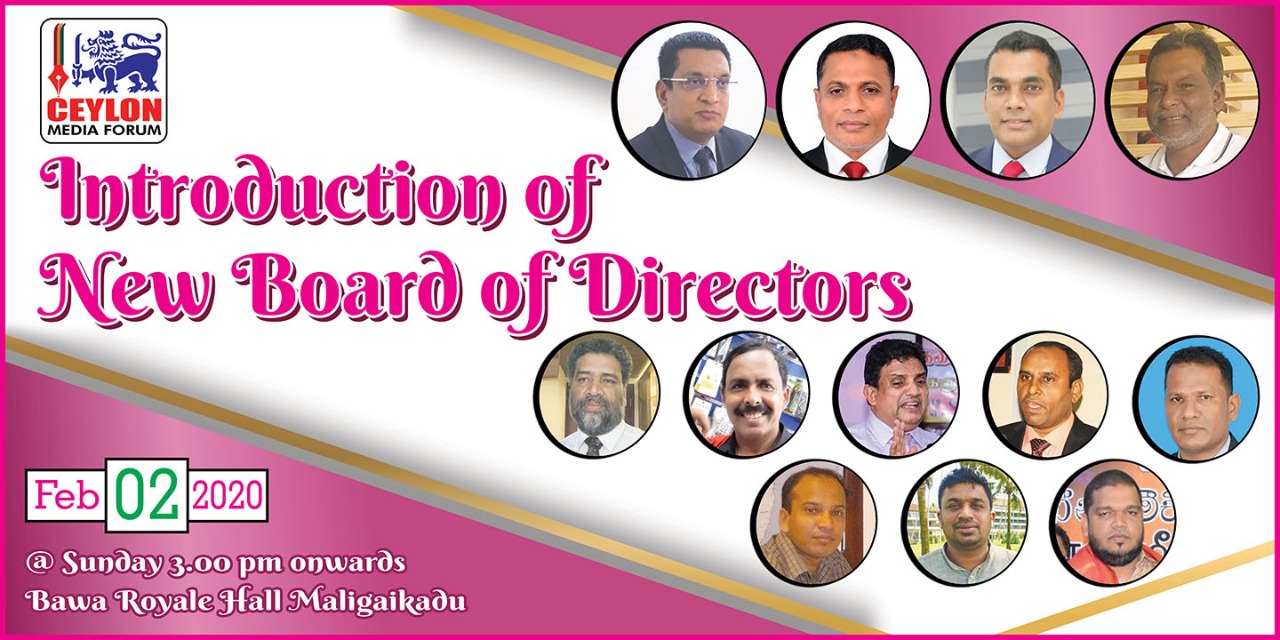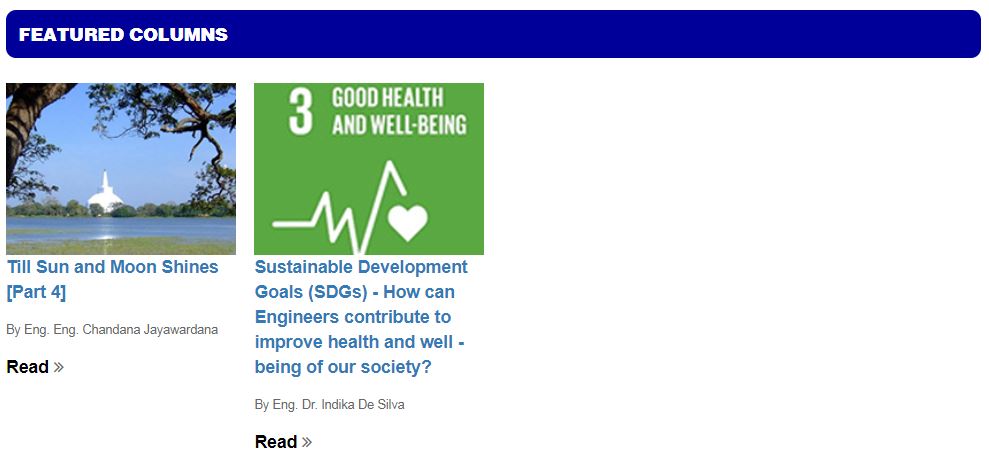
SUSTAINABLE DEVELOPMENT GOAL (SDG 13): ‘CLIMATE ACTION’ – ENGINEERS CANNOT DO AWAY WITH IT
BY ENG. (DR.) SAJA A. A. MAJEED
https://iesl.lk/SLEN/56/SDG.php
“Doing the right thing on climate change should be baked into an engineer’s DNA”
– Anthony Ingraffea, Professor, Cornell University

Climate change has become a major threat to the entire humanity globally. Sri Lanka too continues to experience a number of climate-induced disasters every year, which lead to enormous economic losses and severe impact on social life. Sri Lanka is faced with multi-faceted challenges due to climate change. In the dry zone, there is a regularly severe scarcity of water, the central hill is highly vulnerable to landslide risks and the coastal areas are at higher risk to sea level rise and coastal disasters.
Sri Lanka is right on the hotspot for severe impact due to climate change. A recent World Bank report highlighted that around 17% of the Sri Lankan population is living in the ‘severe’ hotspots, while 70% is living in ‘moderate’ hotspot conditions (Saja et al. 2018). It has been projected that the country would experience economic losses in the range of 6% of GDP under business-as-usual scenarios for the period 2010-2050 unless proper measures of adaptation are initiated to overcome the negative impacts.
Every SDG needs engineers. How can engineers contribute to attain Sustainable Development Goal (SDG) 13 – ‘Climate Action’, which is to take urgent action to combat climate change and its impacts. Climate action is linked to many other SDGs where engineering plays an important role, such as SDG 6 (Clean Water), SDG7 (Affordable Energy), SDG11 (Sustainable Cities and Communities), SDG12 (Responsible Consumption and Production), SDG14 (Life Below Water), and SDG15 (Life on Land). Engineers contribute in the development of resilient infrastructure in the power and energy, transportation, water and telecommunications sectors to mitigate the impacts of climate change. For example, this includes new technology for carbon capture and storage, removing greenhouse gases and the use of materials in the building and construction to develop low carbon living cities.
The key limitation at the governance level to combat climate induced disasters is the lack of preparedness/mitigation plan and systems established at the local government level in Sri Lanka, that adopt and implement local disaster risk reduction strategies in line with national DRR strategies. In Sri Lanka, the disaster management portfolio is managed at the central level through district/divisional disaster management centres at the sub-national/community levels, however local authorities take not much interest in formulating disaster risk management policies on their own apart from some forigen funded projects in the selected Municipalities and Urban Councils. These forigen funded projects were also limited to developing plans and most of the local authorities hardly allocated a significant portion of their budget for resilience building initiatives due to more urgent priorities in the to-do list. Since the implementation of climate risk mitigation policies and plans requires mainstreaming actions in different sectors, the lack of institutional coordination and capacity among different stakeholder agencies are the key challenges that need to be addressed urgently. An integrated mechanism as shown in Figure 13.1 including development, disaster management and climate/environment departments at the national, sub-national and local levels may need to be established to overcome the challenges in duplication and gaps in the risk-sensitive development planning and implementation. engineers.

Fig. 13.1. Mechanism for climate and disaster risk sensitive development plan assessment from village to national level (Saja et al. 2019)
Global key figures related to ‘Climate Action’ (SDG13)
Some of the relevant global key figures related to ‘Climate Action’ provided in the United Nation statistics include (https://sdgs.un.org/goals/goal13):
- Compared to 2010, emissions from developed countries fell by approximately 6.2% in 2019, while emissions from developing countries (comprising 70 countries) rose by 14.4% in 2014. In order to limit global warming to 1.5°C, it was recommended to reduce the global emissions by 45% in 2030 compared to 2010 levels.
- Globally, as of April 2020, 118 countries have reported the development and adoption of national and/or local disaster risk reduction strategies, compared to only 48 countries in 2015 when the Sendai Framework was adopted.
SDG 13 (Climate Action) targets
SDG 13 sets out three key targets and two additional targets (13.a and 13.b) for resource mobilisation and policy to be achieved by 2030. The five key targets are:
13.1 Strengthen resilience and adaptive capacity to climate-related hazards and natural disasters in all countries
13.2 Integrate climate change measures into national policies, strategies and planning
13.3 Improve education, awareness-raising and human and institutional capacity on climate change mitigation, adaptation, impact reduction and early warning
13.A Implement the commitment undertaken by developed-country parties to the United Nations Framework Convention on Climate Change to a goal of mobilizing jointly $100 billion annually by 2020 from all sources to address the needs of developing countries in the context of meaningful mitigation actions and transparency on implementation and fully operationalize the Green Climate Fund through its capitalization as soon as possible
13.B Promote mechanisms for raising capacity for effective climate change-related planning and management in least developed countries and small island developing States, including focusing on women, youth and local and marginalized communities; Acknowledging that the United Nations Framework Convention on Climate Change is the primary international, <br>intergovernmental forum for negotiating the global response to climate change

Detail indicator descriptions are available at https://unstats.un.org/sdgs
SDG 13 (Climate Action) target indicators (examples)
The achievement of ‘Climate Action’ goal is measured by the following set of key indicators:
- Number of deaths, missing persons and persons affected by disaster per 100,000 people
- Number of countries with national and local disaster risk reduction strategies
- Proportion of local governments that adopt and implement local disaster risk reduction strategies in line with national disaster risk reduction strategies
- Number of countries that have communicated the establishment or operationalization of an integrated policy/strategy/plan which increases their ability to adapt to the adverse impacts of climate change, and foster climate resilience and low greenhouse gas emissions development in a manner that does not threaten food production (including a national adaptation plan, nationally determined contribution, national communication, biennial update report or other)
- Number of countries that have integrated mitigation, adaptation, impact reduction and early warning into primary, secondary and tertiary curricula
- Number of countries that have communicated the strengthening of institutional, systemic and individual capacity-building to implement adaptation, mitigation and technology transfer, and development actions
Current status of SDG 13 progression in Sri Lanka
The current status of achieving SDG 13 in Sri Lanka was reported in the recent review by the Government of Sri Lanka (SLVNR 2018). Some of the key contributions include:
- The generation of GHG emissions is estimated to be 2.16 tons of annual emissions per capita in Sri Lanka
- The number of deaths, people missing, and affected by disasters have been consistent annually with higher numbers in some years due to worst disaster events such as flooding and landslides (For example in 2017, 281 people died and 152 people went missing compared to lower numbers in other years)
- Sri Lanka has formulated the National Climate Change Policy (NCCP) in 2011, prepared the National Adaptation Plan for Climate Change Impacts 2016-2025 (NAP-CC), and submitted NDCs for adaptation, mitigation and loss and damage in 2016, which are the key achievements related to SDG 13
- The NAP-CC identified adaptation actions for nine vulnerable sectors, namely; food security (crop-livestock-fisheries), water, health, human settlements, biodiversity and ecosystems, coastal and marine, export agriculture, industry energy-transportation, and tourism.
Role of engineering to advance SDG 13 – ‘Climate Action’
Some selected examples from world reputed engineering organizations are provided below briefly:
- The World Federation of Engineering Organizations (WFEO) committee on Engineering and Environment (CEE) developed a guide for engineers: “Model Code of Practice: Principles of Climate Change Adaptation for Engineers”. This code highlights the key aspects in developing climate and disaster risk sensitive infrastructure. The nine key principles are categorized into three categories: 1.Professional judgment, 2.Integrating Climate Information, and 3.Practice guidance. An amplification plan and a number of suggestions for implementation to address the climate change challenges are given for each of these principles. Every young and experienced engineer should be aware of these principles which will help them to be responsible engineers (WEFO 2015).
- Engineers are leading the research on the low carbon living in cities under the Low Carbon Living Cooperative Research Centre Project in Australia. Chemical Engineers developed a technology to remove carbon from air. The new technologies for example, that use low-carbon concrete for construction or Negative Emissions Technology (NET) can help to considerably reduce greenhouse gas emissions (UNESCO 2021).
- As highlighted in the IPCC (2018) report, limiting global warming to 1.5 degree celsius will require multi-stakeholder engagement and rapid changes in “Business as-usual” strategies. Each segment of engineering needs to have climate action plan with the key climate change adaptation goals and reducing GHG emissions (EGBC 2021).
- However, there are many ethical dilemmas for engineers in striking a balance and leveraging an optimal trade-off between the rapidly increasing demand for example in the energy sector and opting for the most viable option with less harm to the environment. For example, some key questions include: will nuclear power cause more problems than it solves, is CO2 capture & storage an acceptable option, are improvements in technical efficiency just undermined by more consumption, and will reducing GHG emissions conflict with international development? (Parkinson 2003).
Next SDG: SDG 14 – Life below water
In the next issue of digital SLEN, we will continue with the snapshot of SDG 14: “Life below water‘’. All SDGs are well connected, and thus require a holistic view to address real development challenges. Until then, let us reflect on SDG 14: ‘Life below water’ and its central role in the Engineering sector and profession. Your comments on how we as engineers can contribute to achieve SDGs can be posted in the IESL Facebook page https://www.facebook.com/IESLSriLanka/.
References
- https://unstats.un.org/sdgs/indicators/Global%20Indicator%20Framework%20after%202019%20refinement_Eng.pdf
- https://country-profiles.unstatshub.org/lka#goal-13
- Sri Lanka Voluntary National Review (SLVNR) on the Status of Implementing Sustainable Development Goals, 2018. Ministry of Sustainable Development, Wildlife and Regional Development, Published by the Ministry of Sustainable Development, Wildlife and Regional Development in June, 2018.
- UNESCO (2021) United Nations Educational, Scientific and Cultural Organization, Engineering for Sustainable Development – Delivering on the Sustainable Development Goals, March 2021, https://unesdoc.unesco.org/ark:/48223/pf0000375644/PDF/375644eng.pdf.multi
- https://dashboards.sdgindex.org/static/countries/profiles/Sri%20Lanka.pdf
- https://wec2019.org.au/2019/09/05/every-sustainable-development-goals-needs-engineers/
- The Royal Academy of Engineering, UK, Engineering for Sustainable Development: Guiding Principles, 2005, ISBN: 1-903496-21-7 https://www.ewb-uk.org/wp-content/uploads/2020/02/RAEng-Engineering_for_Sustainable_Development-0509.pdf
- Saja, AMA, Sahid, ML, & Sutharshanan, M. (2020). Implementing Sendai Framework priorities through risk-sensitive development planning–A case study from Sri Lanka. Progress in Disaster Science, 5, 100051.
- Saja AMA, Disasters one after the other – A serious threat to the economy of the nation!, Financial Times Special Features, 18 October 2018, http://www.ft.lk/opinion/Disasters-one-after-the-other-%E2%80%93-A-serious-threat-to-the-economy-of-the-nation-/14-664953
- WEFO, 2015, Model Code of Practice: Principles of Climate Change Adaptation for Engineers, https://engineerscanada.ca/sites/default/files/wfeo-model-code-of-practice-principles-climate-change-adaptation-engineers.pdf, December 2005
- ENGINEERS AND GEOSCIENTISTS BRITISH COLUMBIA, CLIMATE CHANGE ACTION PLAN VERSION 1.0 PUBLISHED MARCH 2021
- Tackling Climate Change – the role of the engineer, Stuart Parkinson, SGR, at Women’s Engineering Society annual conference, ‘Proper Practice: Professionalism and Ethics in Engineering and Science’ 12th Sept, 2003 at the Earth Centre, Doncaster, UK https://www.sgr.org.uk/resources/tackling-climate-change-role-engineer

Eng. Saja A.A. Majeed
BscEng, MScEng, PhD
Lecturer
Faculty of Engineering
South Eastern University of Sri Lanka


